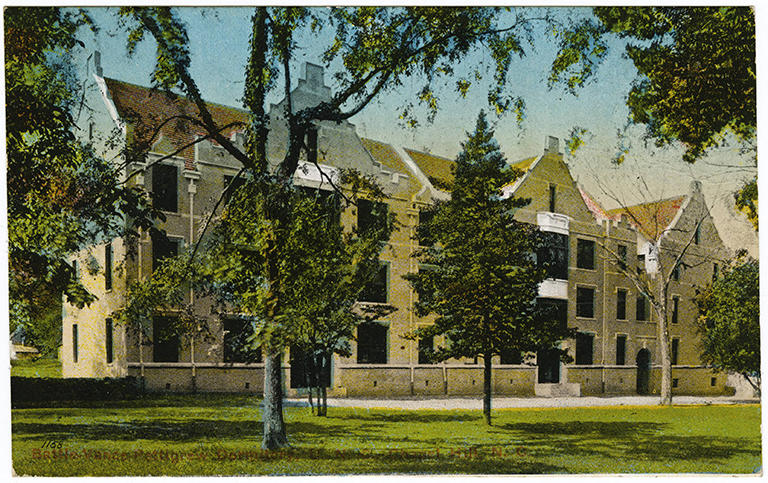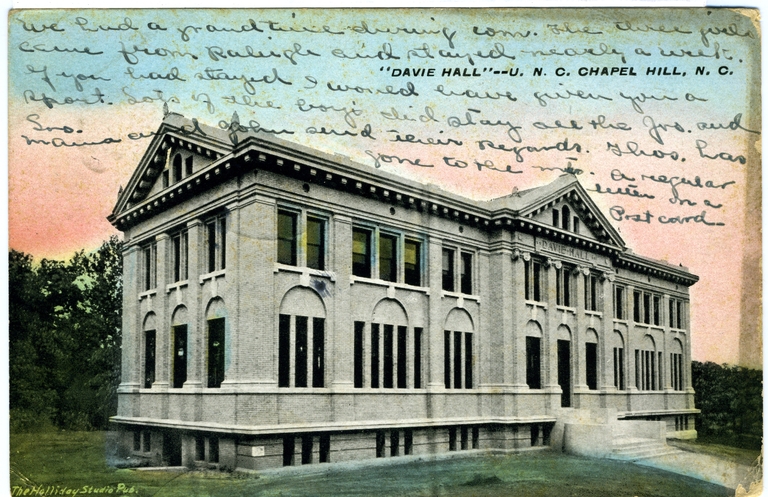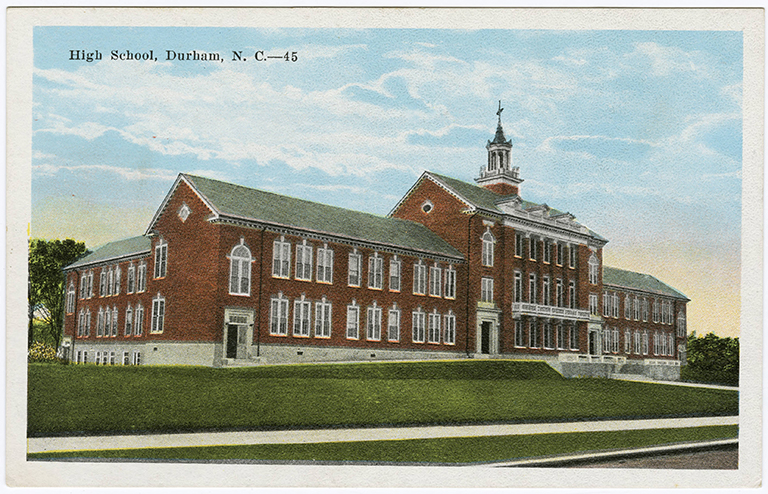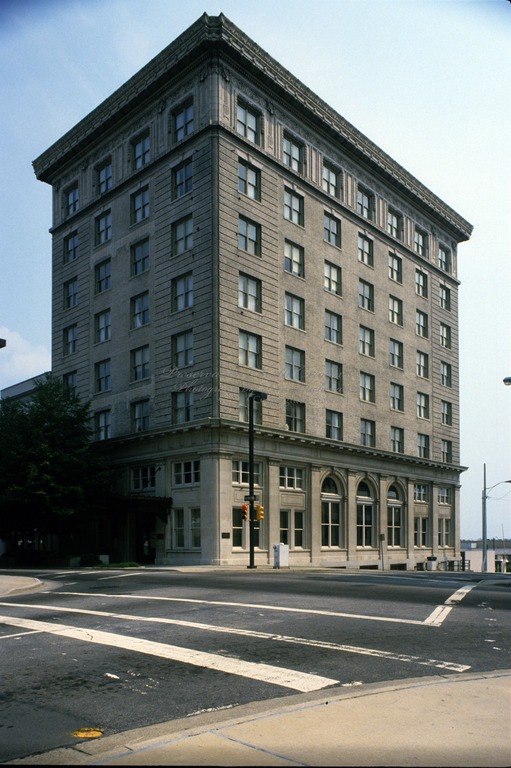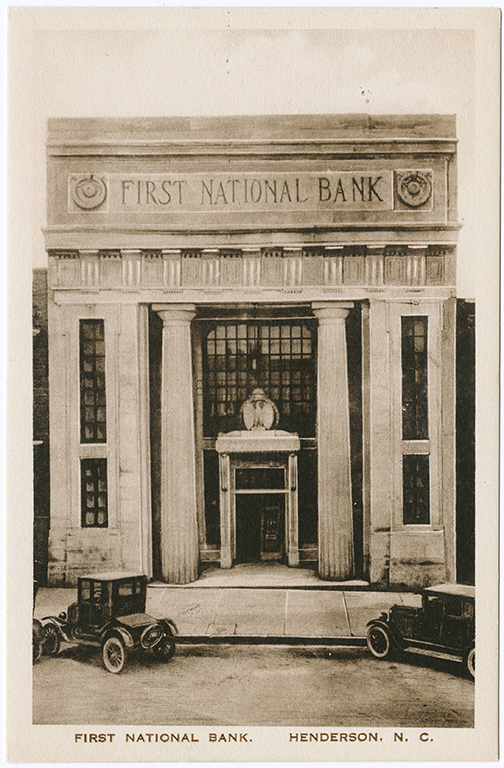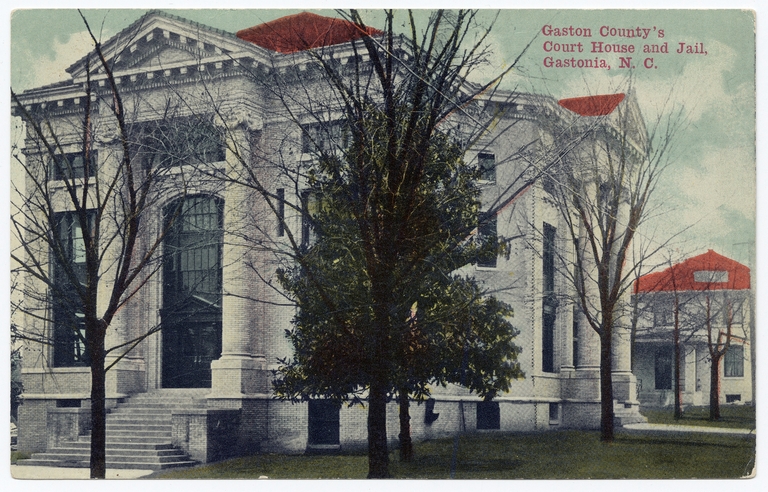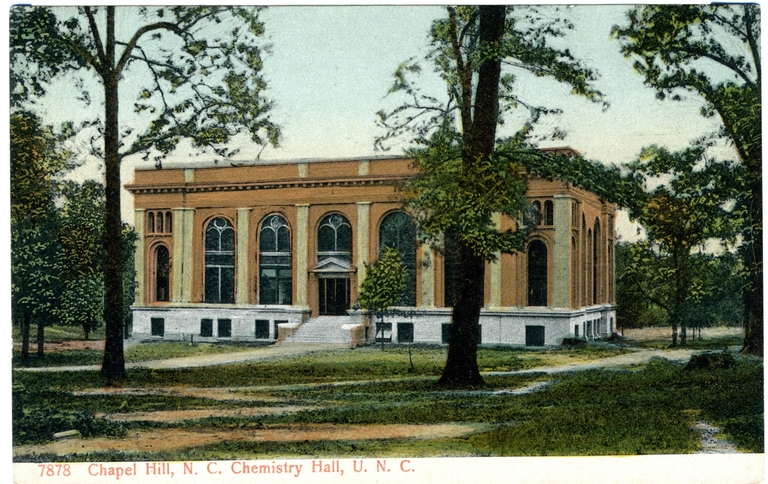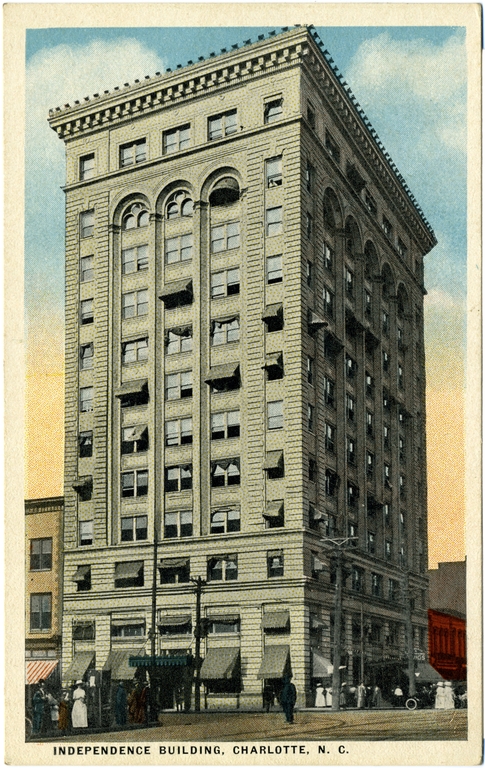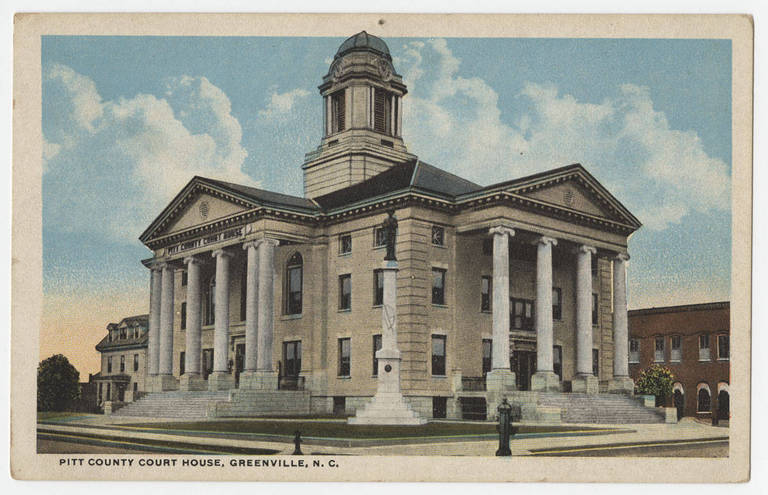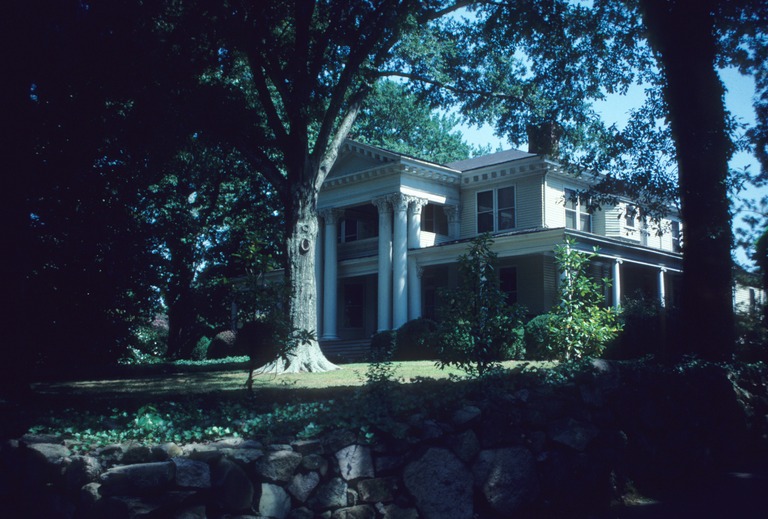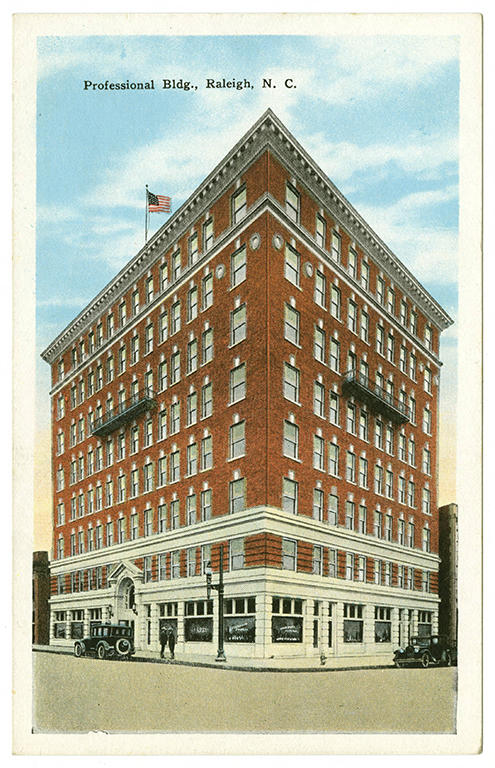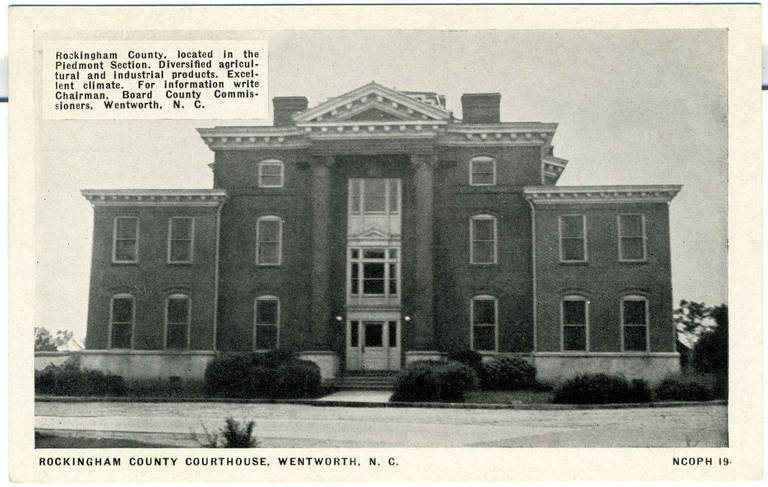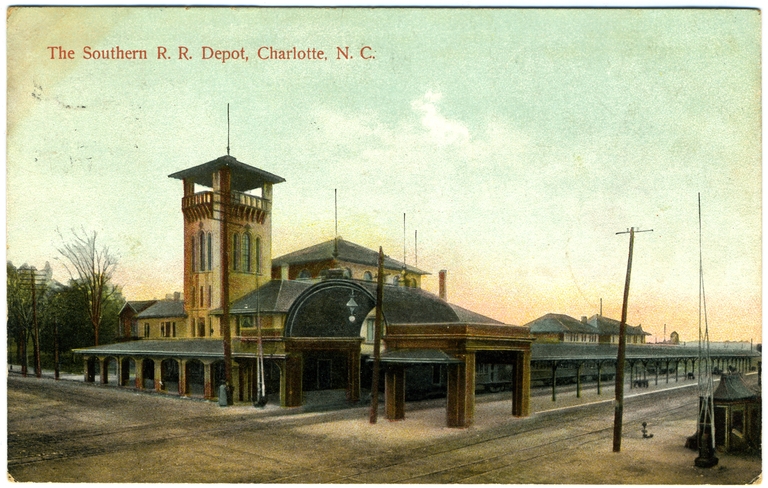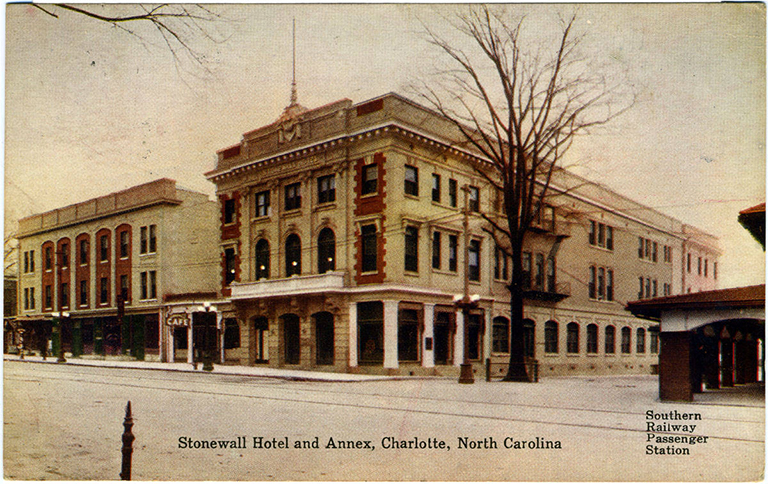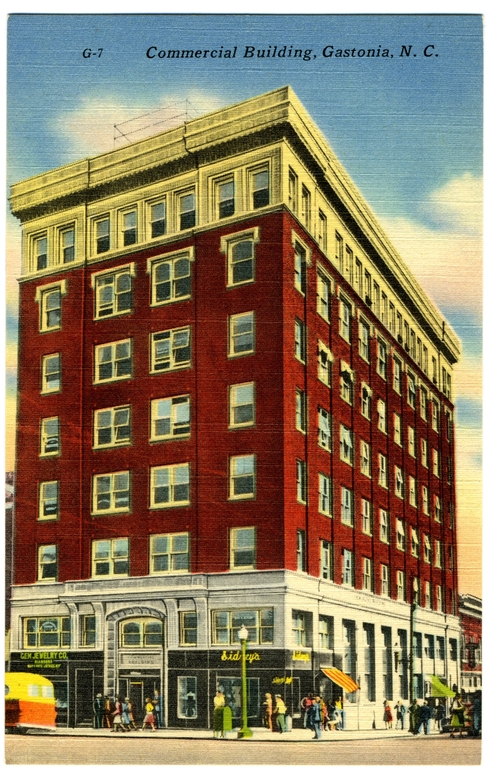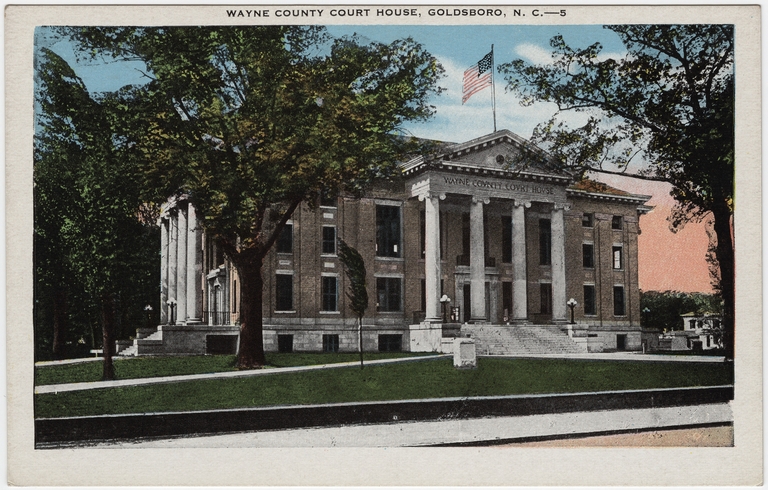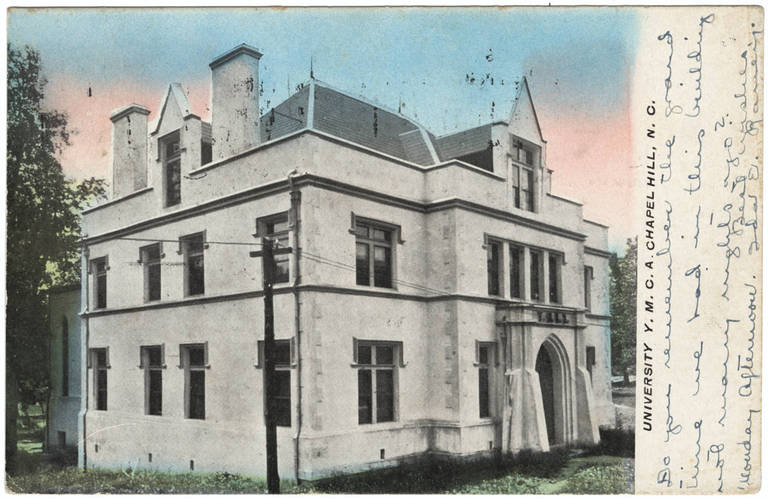Heister, Michael (1870-1948)
Birthplace:
Cincinnati, Ohio
Residences:
- Bellevue, Ky
- Columbia, SC
- Washington D. C.
Trades:
- Architect
Building Types:
Styles & Forms:
Beaux-Arts; Colonial Revival; Gothic Revival; Romanesque Revival
Michael Heister (1870-1948), a native of Ohio, was an architect active in North Carolina and much of the South in the first half of the twentieth century. He was the chief designer in the prolific firm of the better known architect Frank Pierce Milburn (1868-1926). He worked with Milburn as a draftsman ca. 1900-1909 and from 1909 onward as a partner in Milburn, Heister, and Company. The association proved to be long-lived and productive. Although overshadowed in the public view by Milburn, Heister’s regular identification as the chief designer for the firm suggests that he was responsible for the character of many of its key buildings, including prominent edifices in free versions of Beaux Arts neoclassicism.
Michael Heister was born in Ohio on March 23, 1870, a son of John Heister, a native of Germany, and Bernadina Doecker. By 1900, at age 30, he was listed in the census as an architect residing in Bellevue, Kentucky (across the Ohio River from Cincinnati) in a household with his widowed father and his younger sister.
Frank Milburn (a native of Kentucky and only two years older than Heister) had commissions in Kentucky in this period, and likely met Heister in Kentucky and recognized his ability and presumably their compatibility. Milburn made effective use of his own publications and contacts with newspapers to promote the firm. In his 1901 publication, Designs from the Work of Frank P. Milburn, Architect, Columbia, S. C., Milburn announced in the preface that Heister, the “well-known designer . . . is now associated with me in the draughting department.” The association proved lasting and productive. In 1903 Heister became head of the drafting department.
The Washington Post of February 23, 1907, carried a long and laudatory article about the architectural firm of Frank P. Milburn and Company newly established in the national capital. Likely reflecting promotional information provided by the firm, the newspaper noted that although “practically newcomers to the city, there is perhaps no firm of architects throughout the Southern country who are more widely or more favorably known.” Among the works cited were buildings for the Southern Railway for many years, and “the new buildings to be erected at the University of North Carolina.” The article cited Frank Milburn as head of the company, George P. Kepler as the engineer, and Michael Heister as “the designer of the firm.” Of Heister, the article continued, “it can readily be seen by the class of work that he has done for the firm that he is a designer of much brilliancy and versatility.” Heister “also has full charge of the offices, and superintends the preparation of the plans and specifications.”
The Washington Post of January 17, 1909, announced the renaming of the firm as Milburn, Heister, and Company, which had its main office in the national capital. Portraits of both partners accompanied the article. Heister, along with Milburn, was quick to gain a license to practice architecture in North Carolina after the passage of the licensing act of 1915: Heister’s license certificate of 1915 was #2 (Milburn’s was #3) in the registration book of the North Carolina Board of Architecture. They were among several men who were licensed by the state based on previous architectural practice and experience.
As noted in the entries for Frank P. Milburn and for Milburn, Heister, and Company, the firm’s best known works in North Carolina included buildings at the University of North Carolina; steel-frame office towers with classical styling such as the Independence Building (Realty Building) in Charlotte (1908-1909), the First National Bank Building (1913-1915) in Durham, and the Wachovia Bank and Trust Company Building (1911, 1917-1918) in Winston-Salem; and courthouses in at least eight North Carolina counties. The largest of the courthouses was the towering Buncombe County Courthouse (1927) in Asheville, where the Milburn firm’s classical design was chosen by the county commissioners over an Art Deco scheme proposed by Asheville architect Douglas D. Ellington as a partner to his nearby City Building. The respective roles of Milburn and Heister in defining the designs of their work remain unclear, especially since Milburn affirmed his importance as the head of the firm.
In 1920 at age 49, architect Heister headed a large household in Washington that included his wife, Mary Stella, also of German parentage and born in Ohio, and six children born in South Carolina and the District of Columbia. Heister was active in a number of prestigious clubs and organizations in the capital.
During this time Frank’s son Thomas Yancey Milburn joined the firm. The Durham Morning Herald of November 12, 1922, reported on the company’s work and its offices in Durham, Fayetteville, Gastonia, and Elizabeth City, with headquarters in Washington, D. C. It identified Frank Milburn as president, Michael Heister as “one of the vice presidents, and designer,” and (Thomas) Yancey Milburn, as another vice president. For a time the younger Milburn headed the Durham office and took a lead role in North Carolina projects, especially those in and around Durham. It is possible that as the firm grew, some of the designs were produced by other staff members, but Heister was always identified as the chief designer. Moreover, the consistency of the firm’s output suggests strong creative oversight by Heister.
After Frank Milburn retired in 1925 and died in 1926, the firm continued with Michael Heister and Thomas Yancey Milburn until 1934. (After Heister retired, the younger Milburn subsequently practiced on his own and died in 1977.) In 1940 the census listed Heister as aged 70 and head of a household in Washington, D. C. that included his wife, Stella, 66; his sister Adelaide, 66; and children aged from 18 to 33. Heister died at the age of 77 in 1948, in Washington, D.C.
Claudia P. Roberts (Brown) and Diane Lea, The Durham Architectural Survey and Historic Inventory (1982).
Daniel J. Vivian, “‘A Practical Architect’: Frank P. Milburn and the Transformation of Architectural Practice in the New South, 1890-1925,” Winterthur Portfolio (Spring 2005).
Alexander Motor Company Building
Contributors:Frank Pierce Milburn, architect; Milburn, Heister, and Company, architects; Michael Heister, architectDates:1923
Location:Durham, Durham CountyStreet Address:330 E. Main St., Durham, NC
Status:Standing
Type:Commercial
Images Published In:Claudia P. Roberts (Brown) and Diane E. Lea, The Durham Architectural and Historic Inventory (1982).
Battle-Vance-Pettigrew Dormitory
Contributors:Frank Pierce Milburn, architect; Milburn, Heister, and Company, architects; Michael Heister, architectDates:1912
Location:Chapel Hill, Orange CountyStreet Address:University of North Carolina, Chapel Hill, NC
Status:Standing
Type:Educational
Images Published In:John V. Allcott, The Campus at Chapel Hill: Two Hundred Years of Architecture (1986).
M. Ruth Little, The Town and Gown Architecture of Chapel Hill, North Carolina, 1795-1975 (2006).Note:Thomas Wolfe roomed here while he was a student at the university.
Buncombe County Courthouse
Contributors:Frank Pierce Milburn, architect; Milburn, Heister, and Company, architects; Michael Heister, architect (1927)Dates:1927
Location:Asheville, Buncombe CountyStreet Address:60 Court Square, Asheville, NC
Status:Standing
Type:Public
Images Published In:Catherine W. Bishir, Michael T. Southern, and Jennifer F. Martin, A Guide to the Historic Architecture of Western North Carolina (1999).
Bynum Gymnasium
Contributors:Frank Pierce Milburn, architect; Michael Heister, architectDates:1904
Location:Orange CountyStreet Address:University of North Carolina Campus, Chapel Hill, NC
Status:Standing
Type:Educational
Charlotte National Bank Building
Contributors:Frank Pierce Milburn, architect; Michael Heister, architectDates:Ca. 1903
Location:Charlotte, Mecklenburg CountyStreet Address:Charlotte, NC
Status:No longer standing
Type:Commercial
Charlotte Sanatorium
Contributors:Frank Pierce Milburn, architect; Michael Heister, architectDates:Ca. 1903
Location:Charlotte, Mecklenburg CountyStreet Address:127 S. 7th St. (at Church St.), Charlotte, NC
Status:No longer standing
Type:Commercial
Images Published In:Mary Norton Kratt and Mary Manning Boyer, Remembering Charlotte: Postcards from a New South City, 1905-1950 (2000).
Davie Hall
Contributors:Frank Pierce Milburn, architect; Michael Heister, architectDates:1908
Location:Chapel Hill, Orange CountyStreet Address:University of North Carolina, Chapel Hill, NC
Status:No longer standing
Type:Educational
Dillard House
Contributors:Frank Pierce Milburn, architect; Milburn, Heister, and Company, architects; Michael Heister, architectDates:1917
Location:Durham, Durham CountyStreet Address:1311 N. Mangum St., Durham, NC
Status:Standing
Type:Residential
Images Published In:Claudia P. Roberts (Brown) and Diane E. Lea, The Durham Architectural and Historic Inventory (1982).
Durham Auditorium
Contributors:Frank Pierce Milburn, architect; Milburn, Heister, and Company, architects; Michael Heister, architectVariant Name(s):Carolina Theatre
Dates:1926
Location:Durham, Durham CountyStreet Address:211 Roney St., Durham, NC
Status:Standing
Type:Commercial
Images Published In:Claudia P. Roberts (Brown) and Diane E. Lea, The Durham Architectural and Historic Inventory (1982).
Durham City Hall
Contributors:Frank Pierce Milburn, architect; Milburn, Heister, and Company, architects; Michael Heister, architectDates:1904; 1926 [remodeled]
Location:Durham, Durham CountyStreet Address:120 Morris St., Durham, NC
Status:Standing
Type:Public
Images Published In:Claudia P. Roberts (Brown) and Diane E. Lea, The Durham Architectural and Historic Inventory (1982).
Note:The building was erected as a high school in 1904 and remodeled as the city hall in 1926.
Durham County Courthouse
Contributors:Frank Pierce Milburn, architect; Milburn, Heister, and Company, architects; Michael Heister, architectDates:1916
Location:Durham, Durham CountyStreet Address:208 E. Main St., Durham, NC
Status:Standing
Type:Public
Images Published In:Catherine W. Bishir and Michael T. Southern, A Guide to the Historic Architecture of Piedmont North Carolina (2003).
Claudia P. Roberts (Brown) and Diane E. Lea, The Durham Architectural and Historic Inventory (1982).
Daniel J. Vivian, “‘A Practical Architect’: Frank P. Milburn and the Transformation of Architectural Practice in the New South, 1890-1925,” Winterthur Portfolio (Spring 2005).
Durham High School
Contributors:Frank Pierce Milburn, architect; Milburn, Heister, and Company, architects; Michael Heister, architectDates:1930
Location:Durham, Durham CountyStreet Address:N. Duke St., Durham, NC
Status:Standing
Type:Educational
Images Published In:Claudia P. Roberts (Brown) and Diane E. Lea, The Durham Architectural and Historic Inventory (1982).
Elizabeth City High School
Contributors:Frank Pierce Milburn, architect; Milburn, Heister, and Company, architects; Lord Byron Perry, contractor; Michael Heister, architectDates:1921
Location:Elizabeth City, Pasquotank CountyStreet Address:306 N. Road St., Elizabeth City, NC
Status:Standing
Type:Educational
Images Published In:Thomas R. Butchko, On the Shores of the Pasquotank: The Architectural Heritage of Elizabeth City and Pasquotank County, North Carolina (1989).
Empire Hotel
Contributors:Dates:1855; 1907
Location:Salisbury, Rowan CountyStreet Address:212-226 S. Main St., Salisbury, NC
Status:Standing
Type:Commercial
Images Published In:Catherine W. Bishir and Michael T. Southern, A Guide to the Historic Architecture of Piedmont North Carolina (2003).
Davyd Foard Hood, The Architecture of Rowan County North Carolina: A Catalogue and History of Surviving 18th, 19th, and Early 20th Century Structures (1983).Note:Frank P. Milburn designed a thorough remodeling of the antebellum Boyden Hotel, creating a bold façade with free classical details and contrasting red and cream brickwork.
First National Bank Building
Contributors:Frank Pierce Milburn, architect; Michael Heister, architect (1913-1915)Dates:1913-1915
Location:Durham, Durham CountyStreet Address:123 W. Main St., Durham, NC
Status:Standing
Type:Commercial
Images Published In:Catherine W. Bishir, North Carolina Architecture (1990).
Claudia P. Roberts (Brown) and Diane E. Lea, The Durham Architectural and Historic Inventory (1982).
Daniel J. Vivian, “‘A Practical Architect’: Frank P. Milburn and the Transformation of Architectural Practice in the New South, 1890-1925,” Winterthur Portfolio (Spring 2005).
First National Bank of Henderson
Contributors:Frank Pierce Milburn, architect; Milburn, Heister, and Company, architects; Michael Heister, architectDates:1921
Location:Henderson, Vance CountyStreet Address:213-215 S. Garnett St., Henderson, NC
Status:Standing
Type:Commercial
Images Published In:Ann Melanie Murphy, An Inventory of Historic Architecture, Henderson, North Carolina (1979).
First Presbyterian Church
Contributors:Frank Pierce Milburn, architect; Milburn, Heister, and Company, architects; Michael Heister, architectDates:1916
Location:Durham, Durham CountyStreet Address:305 E. Main St., Durham, NC
Status:Standing
Type:Religious
Images Published In:Claudia P. Roberts (Brown) and Diane E. Lea, The Durham Architectural and Historic Inventory (1982).
Gaston County Courthouse
Contributors:Frank Pierce Milburn, architect; Milburn, Heister, and Company, architects; Michael Heister, architectDates:1911
Location:Gastonia, Gaston CountyStreet Address:151 South St., Gastonia, NC
Status:Standing
Type:Public
Images Published In:Catherine W. Bishir and Michael T. Southern, A Guide to the Historic Architecture of Piedmont North Carolina (2003).
Hill Hall
Contributors:Atwood and Nash, architects and engineers (1930); Thomas C. Atwood, engineer (1930); J. A. Jones, contractor (1907); Frank Pierce Milburn, architect (1907); Arthur C. Nash, architect (1930); Michael Heister, architectVariant Name(s):Carnegie Library
Dates:1907; 1930 [remodeled]
Location:Chapel Hill, Orange CountyStreet Address:University of North Carolina, Chapel Hill, NC
Status:Standing
Type:Educational
Images Published In:M. Ruth Little, The Town and Gown Architecture of Chapel Hill, North Carolina, 1795-1975 (2006).
Daniel J. Vivian, “‘A Practical Architect’: Frank P. Milburn and the Transformation of Architectural Practice in the New South, 1890-1925,” Winterthur Portfolio (Spring 2005).Note:The building was erected in 1907 as a library and was later expanded and updated as a music building; it has since been renovated again.
Hoke County Courthouse
Contributors:Frank Pierce Milburn, architect; Milburn, Heister, and Company, architects; Michael Heister, architectDates:1911
Location:Raeford, Hoke CountyStreet Address:Main St. and Edenborough St., Raeford, NC
Status:Standing
Type:Public
Howell Hall
Contributors:Frank Pierce Milburn, architect; Michael Heister, architectDates:1906
Location:Chapel Hill, Orange CountyStreet Address:University of North Carolina, Chapel Hill, NC
Status:Standing
Type:Educational
Independence Building
Contributors:J. A. Jones, builder (1908-1909); Frank Pierce Milburn, architect (1908-1909); Milburn, Heister, and Company, architects (1908-1909); William Lee Stoddart, architect (1927-1928); Michael Heister, architect (1908-1909)Variant Name(s):Realty Building
Dates:1908-1909; 1927-1928 [addition]
Location:Charlotte, Mecklenburg CountyStreet Address:100-102 W. Trade St., Charlotte, NC
Status:No longer standing
Type:Commercial
Images Published In:Mary Norton Kratt and Mary Manning Boyer, Remembering Charlotte: Postcards from a New South City, 1905-1950 (2000).
Daniel J. Vivian, “‘A Practical Architect’: Frank P. Milburn and the Transformation of Architectural Practice in the New South, 1890-1925,” Winterthur Portfolio (Spring 2005).Note:The 12-story skyscraper was the first steel-framed skyscraper in North Carolina and an icon of Charlotte’s urban ambitions. Originally known as the Realty Building, it was renamed in 1922 for the Independence Bank that occupied it. In 1928, New York architect William Lee Stoddart added two more stories. It was imploded in 1981 amid strong controversy.
King's Daughters Home
Contributors:Frank Pierce Milburn, architect; Milburn, Heister, and Company, architects; Michael Heister, architectDates:1925
Location:Durham, Durham CountyStreet Address:204 N. Buchanan Blvd., Durham, NC
Status:Standing
Type:Residential
Images Published In:Claudia P. Roberts (Brown) and Diane E. Lea, The Durham Architectural and Historic Inventory (1982).
Lincoln Hospital
Contributors:Frank Pierce Milburn, architect; Milburn, Heister, and Company, architects; Michael Hesiter, architectDates:1924
Location:Durham, Durham CountyStreet Address:1301 Fayetteville St., Durham, NC
Status:No longer standing
Type:Health Care
Images Published In:Claudia P. Roberts (Brown) and Diane E. Lea, The Durham Architectural and Historic Inventory (1982).
Mary Ann Smith Building
Contributors:Dates:1904
Location:Chapel Hill, Orange CountyStreet Address:University of North Carolina Campus, Chapel Hill, NC
Status:Standing
Type:Educational
Images Published In:John V. Allcott, The Campus at Chapel Hill: Two Hundred Years of Architecture (1986).
M. Ruth Little, The Town and Gown Architecture of Chapel Hill, North Carolina, 1795-1975 (2006).
McPherson Hospital
Contributors:Frank Pierce Milburn, architect; Milburn, Heister, and Company, architects; Michael Heister, architectDates:1926
Location:Durham, Durham CountyStreet Address:1110 W. Main St., Durham, NC
Status:Standing
Type:Health Care
Images Published In:Claudia P. Roberts (Brown) and Diane E. Lea, The Durham Architectural and Historic Inventory (1982).
Pitt County Courthouse
Contributors:William Carter Bain, contractor; Frank Pierce Milburn, architect; Milburn, Heister, and Company, architects; Michael Heister, architectDates:1910-1911
Location:Greenville, Pitt CountyStreet Address:Greenville, NC
Status:Standing
Type:Public
Images Published In:Catherine W. Bishir, North Carolina Architecture (1990).
Catherine W. Bishir and Michael T. Southern, A Guide to the Historic Architecture of Eastern North Carolina (1996).
Scott Power, The Historical Architecture of Pitt County, North Carolina (1991).
President's House
Contributors:Frank Pierce Milburn, architect; Michael Heister, architectDates:1907
Location:Chapel Hill, Orange CountyStreet Address:400 E. Franklin St., University of North Carolina, Chapel Hill, NC
Status:Standing
Type:Residential
Images Published In:M. Ruth Little, The Town and Gown Architecture of Chapel Hill, North Carolina, 1795-1975 (2006).
Daniel J. Vivian, “‘A Practical Architect’: Frank P. Milburn and the Transformation of Architectural Practice in the New South, 1890-1925,” Winterthur Portfolio (Spring 2005).
Professional Building
Contributors:Frank Pierce Milburn, architect; Milburn, Heister, and Company, architects; John E. Beaman, contractor; Michael Heister, architectDates:1925
Location:Raleigh, Wake CountyStreet Address:209 S. McDowell St., Raleigh, NC
Status:Standing
Type:Commercial
Images Published In:Linda L. Harris and Mary Ann Lee, An Architectural and Historical Inventory of Raleigh, North Carolina (1978).
Note:The 8-story building is one of the modest 1920s skyscrapers that redefined downtown Raleigh’s skyline. It was commissioned by William Allen Erwin (1856-1932), a relative of the Alamance County Holt manufacturing family who worked with the Duke family in their entry into the textile industry and became an industry leader himself. It was built in part as a philanthropic investment, for the some of the proceeds from rentals to physicians, dentists, and various corporations were diverted into a trust that benefited the Chapel of the Cross in Chapel Hill, which Erwin had built and given to the Episcopal Diocese (see Hobart Upjohn). The gala opening of the building was in December, 1925. The architects and the contractor were identified in the December 19, 1925, News and Observer.
Robeson County Courthouse
Contributors:Frank Pierce Milburn, architect; B. F. Smith Fireproof Construction Company, architects and builders; Michael Heister, architectDates:1908
Location:Lumberton, Robeson CountyStreet Address:Chestnut St., Lumberton, NC
Status:No longer standing
Type:Public
Images Published In:Diane E. Lea and Claudia P. Roberts (Brown), An Architectural and Historical Survey: Central Lumberton, North Carolina (1980).
Note:The Robesonian of January 4, 1909, pictured a stout brick courthouse with porticoes and a large cupola. The article cited both the Smith company and Frank Milburn as architects, as identified on a plaque on the building. The nature and extent of their association remains to be explored, but from the appearance of the courthouse, Milburn had a strong role in its design.
Rockingham County Courthouse
Contributors:Frank Pierce Milburn, architect; B. F. Smith Fireproof Construction Company, builders; Michael Heister, architectDates:1907
Location:Wentworth, Rockingham CountyStreet Address:1086 NC 65, Wentworth, NC
Status:Standing
Type:Public
Note:The 3-story brick building is built of pressed brick, including the columns at the entrance. The Reidsville Webster’s Weekly of April 4, 1907, cited the Smith firm and mentioned that the company had installed fireproof vaults in the previous courthouse, which burned in 1906. The 3-story building is larger than most of the courthouses credited to Smith’s firm and likely reflects Milburn’s role as architect.
Rocky Mount National Bank
Contributors:Frank Pierce Milburn, architect; Milburn, Heister, and Company, architects; Michael Heister, architect; D.J. Rose, contractorDates:Ca. 1918
Location:Rocky Mount, Edgecombe CountyStreet Address:101 Southeast Main St., Rocky Mount, NC
Status:Standing
Type:Commercial
Images Published In:Catherine W. Bishir and Michael T. Southern, A Guide to the Historic Architecture of Eastern North Carolina (1996).
Rocky Mount Savings Bank
Contributors:Frank Pierce Milburn, architect; Milburn, Heister, and Company, architects; Michael Heister, architectDates:1926
Location:Rocky Mount, Nash CountyStreet Address:142 SW Main St., Rocky Mount, NC
Status:Standing
Type:Commercial
Salisbury Passenger Depot
Contributors:Central Carolina Construction Company, contractors; Frank Pierce Milburn, architect; Michael Heister, architectDates:1907-1908
Location:Salisbury, Rowan CountyStreet Address:Depot St., Salisbury, NC
Status:Standing
Type:Transportation
Images Published In:Catherine W. Bishir, North Carolina Architecture (1990).
Catherine W. Bishir and Michael T. Southern, A Guide to the Historic Architecture of Piedmont North Carolina (2003).Note:Of all the major passenger stations Milburn designed for North Carolina towns, only this one survives. Rescued and restored through local preservation efforts, it is currently a community center and Amtrak station.
Southern Railway Passenger Station #I
Contributors:Frank Pierce Milburn, architect; Michael Heister, architectDates:1905
Location:Charlotte, Mecklenburg CountyStreet Address:Charlotte, NC
Status:No longer standing
Type:Transportation
Images Published In:Mary Norton Kratt and Mary Manning Boyer, Remembering Charlotte: Postcards from a New South City, 1905-1950 (2000).
Southern Railway Station
Contributors:Frank Pierce Milburn, architect; Michael Heister, architectDates:Ca. 1905
Location:Asheville, Buncombe CountyStreet Address:Asheville, NC
Status:No longer standing
Type:Transportation
Southern Railway Station
Contributors:Frank Pierce Milburn, architect; Michael Heister, architectDates:1904-1905
Location:Durham, Durham CountyStreet Address:Durham, NC
Status:No longer standing
Type:Transportation
Spencer YMCA
Contributors:Frank Pierce Milburn, architect; Michael Heister, architectDates:Ca. 1904
Location:Spencer, Rowan CountyStreet Address:S. Salisbury St. at Sixth St., Spencer, NC
Status:No longer standing
Type:Recreational
Stonewall Hotel
Contributors:Frank Pierce Milburn, architect; Michael Heister, architectDates:Ca. 1903/1907
Location:Charlotte, Mecklenburg CountyStreet Address:535 W. Trade St., Charlotte, NC
Status:No longer standing
Type:Commercial
Images Published In:Mary Norton Kratt and Mary Manning Boyer, Remembering Charlotte: Postcards from a New South City, 1905-1950 (2000).
Swain County Courthouse
Contributors:Albert Heath Carrier, architect; Frank Pierce Milburn, attributed architect; Smith and Carrier, architects; Richard Sharp Smith, architect; Michael Heister, architectDates:1908
Location:Bryson City, Swain CountyStreet Address:101 Mitchell St., Bryson City, NC
Status:Standing
Type:Public
Images Published In:Catherine W. Bishir, Michael T. Southern, and Jennifer F. Martin, A Guide to the Historic Architecture of Western North Carolina (1999).
Third National Bank
Contributors:Frank Pierce Milburn, architect; Milburn, Heister, and Company, architects; Michael Heister, architectDates:1923
Location:Gastonia, Gaston CountyStreet Address:195 W. Main St., Gastonia, NC
Status:Standing
Type:Commercial
Union Station
Contributors:Frank Pierce Milburn, architect; Michael Heister, architectDates:1904
Location:Winston-Salem, Forsyth CountyStreet Address:Winston-Salem, NC
Status:No longer standing
Type:Transportation
Images Published In:Molly Grogan Rawls, Winston-Salem in Vintage Postcards (2004).
Vance County Courthouse
Contributors:W. R. Kivett, contractor (1884); Frank Pierce Milburn, architect (1908); Milburn, Heister, and Company, architects (1908); James R. Thrower, architect and builder (1884); Michael Heister, architectDates:1884; 1908 [remodeled]
Location:Henderson, Vance CountyStreet Address:Young St., Henderson, NC
Status:Standing
Type:Public
Images Published In:Ann Melanie Murphy, An Inventory of Historic Architecture, Henderson, North Carolina (1979).
Note:This project was a thorough remodeling of the 1884 courthouse, including a completely new façade.
Wachovia Bank and Trust Company Building
Contributors:William Carter Bain, contractor; Central Carolina Construction Company, contractors; Frank Pierce Milburn, architect (1911, 1917-1918); Milburn, Heister, and Company, architects (1911, 1917-1918); Michael Heister, architect (1911, 1917-1918)Variant Name(s):Wachovia National Bank Building
Dates:1911; 1917-1918 [addition and renovation]
Location:Winston-Salem, Forsyth CountyStreet Address:8 West 3rd St., Winston-Salem, NC
Status:Standing
Type:Commercial
Images Published In:Catherine W. Bishir and Michael T. Southern, A Guide to the Historic Architecture of Piedmont North Carolina (2003).
Edwin E. Bouldin, Jr., Architectural Guide to Winston-Salem and Forsyth County (1978).
Molly Grogan Rawls, Winston-Salem in Vintage Postcards (2004).Note:Wachovia, a banking company that originated in Winston-Salem, began the cit’s early 20th century “race to the sky” with Milburn and Heister’s 7-story steel-framed skyscraper. After the O’Hanlon Building (see Northup and O’Brien) was built to 8 stories in 1914, Wachovia had Milburn and Heister add another story to their edifice. Both were soon eclipsed by taller buildings.
Warren County Courthouse
Contributors:Frank Pierce Milburn, architect; Michael Heister, architectDates:1906-1907
Location:Warrenton, Warren CountyStreet Address:Court Square, Warrenton, NC
Status:Standing
Type:Public
Images Published In:Catherine W. Bishir and Michael T. Southern, A Guide to the Historic Architecture of Piedmont North Carolina (2003).
Wayne County Courthouse
Contributors:Frank Pierce Milburn, architect; Milburn, Heister, and Company, architects; William P. Rose, contractor; Michael Heister, architectDates:1913
Location:Goldsboro, Wayne CountyStreet Address:224 E. Walnut St., Goldsboro, NC
Status:Standing
Type:Public
Images Published In:J. Daniel Pezzoni and Penne Smith, Glimpses of Wayne County, North Carolina: An Architectural History (1998).
Daniel J. Vivian, “‘A Practical Architect’: Frank P. Milburn and the Transformation of Architectural Practice in the New South, 1890-1925,” Winterthur Portfolio (Spring 2005).Note:The courthouse was described as Rose’s work in his interview with the Goldsboro News-Argus, March 1, 1951.
YMCA Building
Contributors:Frank Pierce Milburn, architect; Michael Heister, architectDates:1907
Location:Chapel Hill, Orange CountyStreet Address:University of North Carolina, Chapel Hill, NC
Status:Standing
Type:Educational
Images Published In:John V. Allcott, The Campus at Chapel Hill: Two Hundred Years of Architecture (1986).
M. Ruth Little, The Town and Gown Architecture of Chapel Hill, North Carolina, 1795-1975 (2006).

